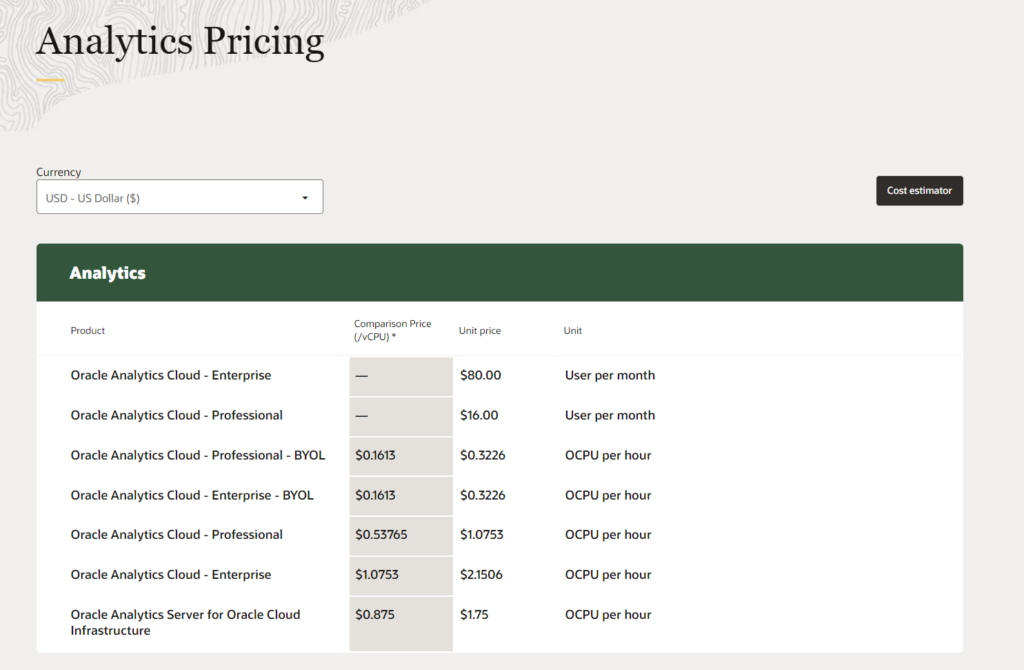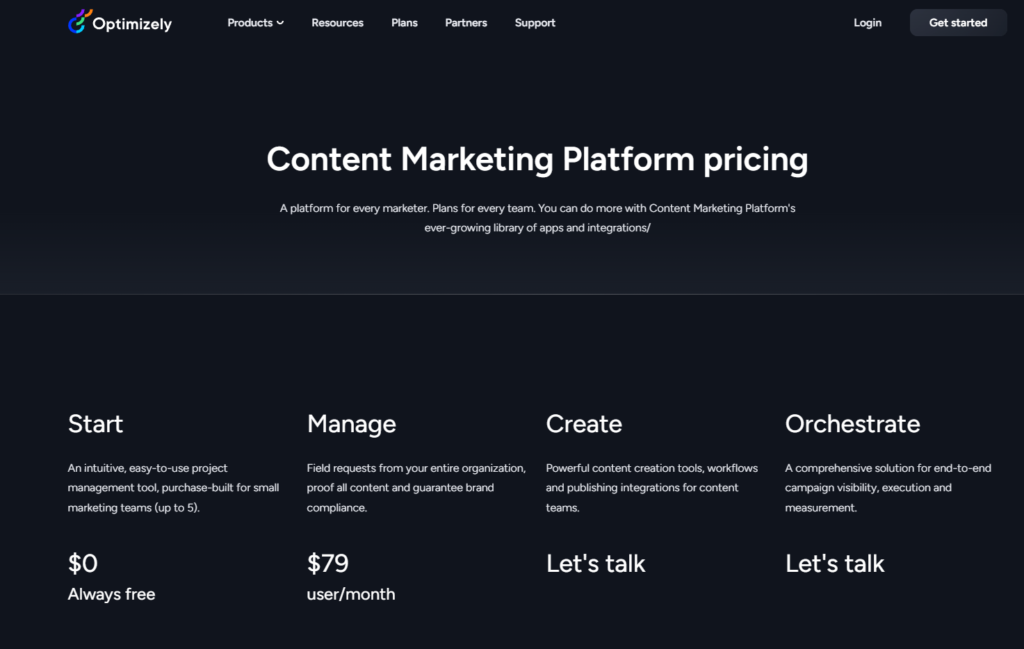In the ever-evolving digital landscape, the right analytics tool isn’t just a nice-to-have; it’s the backbone of informed decision-making. But with so many options on the table, choosing between giants like Oracle Analytics Cloud (OAC) and Optimizely can feel like navigating a maze without a map. Whether you’re a seasoned marketer, a data-driven product manager, or an entrepreneur looking to scale, you’re in the right place. We’re here to break down the complexities, sift through the jargon, and help you find the analytics tool that fits your needs like a glove. Let’s embark on a journey to discover which platform will be your ally in decoding the mysteries of data and turning insights into action.
| Oracle Analytics Cloud | Optimizely |
|---|---|
 |  |
| G2 Score -4.0 out of 5 | G2 Score -4.3 out of 5 |
| TrustRadius Score -8.1 out of 10 | TrustRadius Score -8.6 out of 10 |
Ease of Use and User Interface
In the world of analytics tools, where the complexity of data meets the need for simplicity in analysis, the ease of use and the user interface (UI) become critical factors in selecting the right platform. Let’s see how Oracle Analytics Cloud and Optimizely stack up in these areas.
Oracle Analytics Cloud: A Deep Dive into Data
Oracle Analytics Cloud is like the Swiss Army knife of analytics tools – packed with features, ready for any data challenge. Its UI is designed with the professional analyst in mind, boasting a comprehensive suite of tools that cater to the intricate needs of data scientists and business analysts alike. From advanced analytics to machine learning, OAC provides a broad platform for deep data exploration.
However, with great power comes a steep learning curve. New users might find themselves overwhelmed by the array of options and the technical depth available. Navigating through the layers of functionality in OAC can be daunting at first, but for those willing to climb the learning curve, the rewards are substantial. Oracle has made efforts to streamline the experience, offering guided tutorials and customizable dashboards, yet the platform remains best suited for users with a solid foundation in data analytics.
Optimizely: The User-Friendly Experimenter
Optimizely, on the other hand, takes a different approach. It’s the friendly neighbor of analytics tools, welcoming users with open arms and an intuitive interface. Known for its focus on A/B testing and experimentation, Optimizely simplifies the process of setting up tests and interpreting results, making it accessible to marketers and product managers, not just data experts.
The platform’s UI is clean and straightforward, with a focus on guiding users through the experimentation process step by step. Setting up tests, analyzing results, and implementing changes based on data insights can be done with a few clicks, no advanced degree required. Optimizely excels in making analytics approachable, allowing teams to quickly adapt and make data-driven decisions without getting bogged down in complexity.
Pricing: Oracle Analytics Cloud vs Optimizely
Venturing into the realm of Pricing unveils another layer of consideration in the quest to choose between Oracle Analytics Cloud (OAC) and Optimizely. Pricing strategies can significantly impact an organization’s decision, especially when budget constraints are tight. Let’s dissect the pricing models of these two platforms to see which might offer the better value for your specific needs.
Oracle Analytics Cloud: Tailored for Enterprise Budgets

Oracle Analytics Cloud adopts a pricing model that reflects its enterprise-level service offerings. It is primarily subscription-based, with costs varying depending on the amount of data processed, the level of computational resources utilized, and the specific analytics features required. This model provides flexibility and can scale with the needs of a business, but it also means that pricing can become quite complex, often necessitating a custom quote from Oracle to accurately assess costs.
For businesses with extensive data analytics requirements and the budget to match, OAC’s pricing model offers a good level of predictability and control, especially for organizations that can forecast their data analytics needs effectively. However, small to mid-sized businesses or startups might find the entry point for OAC higher than other platforms due to its comprehensive suite of features designed for larger enterprises.
Optimizely: Flexible Pricing for Growing Businesses

Optimizely’s pricing model is designed with flexibility in mind, catering to businesses of various sizes, from startups to large enterprises. The platform typically offers several tiers, ranging from basic plans suitable for small teams looking to start with experimentation, to more advanced options that include full access to its suite of analytics and personalization tools.
One of the appealing aspects of Optimizely’s pricing is the clarity and scalability it offers. Businesses can start with a lower-tier plan and upgrade as their needs grow, making it a potentially more budget-friendly option for companies in the earlier stages of growth or those with fluctuating experimentation needs.
However, for extensive usage and access to premium features, the costs can increase significantly, which is something larger businesses with more complex requirements need to consider. The platform does provide custom enterprise solutions, which, like OAC, require direct engagement with Optimizely to determine pricing based on specific needs.
Integration Capabilities: Oracle Analytics Cloud vs Optimizely
In our increasingly connected digital landscape, the ability of analytics tools to integrate with other software and services determines how seamlessly businesses can harness data across various platforms.
Oracle Analytics Cloud: The Data Integration Titan
Oracle Analytics Cloud stands tall as a colossus in the realm of data integration. Designed to meet the needs of large enterprises, OAC boasts an impressive array of integration capabilities that enable it to pull data from virtually any source. Be it cloud applications, on-premise databases, or even third-party services, OAC can integrate with a broad spectrum of data environments.
One of OAC’s strengths lies in its flexibility and robustness in handling complex data landscapes. It’s equipped with powerful ETL (Extract, Transform, Load) tools that streamline the process of consolidating data from diverse sources into a cohesive analytics platform. This capability not only enhances data accuracy but also provides a comprehensive view of business operations.
However, the sophistication of OAC’s integration features means that setting up and managing these connections can require a fair amount of technical expertise. While large organizations with dedicated IT departments might find this to be a manageable challenge, smaller teams might encounter a steeper learning curve.
Optimizely: Streamlined for Marketing Ecosystems
Optimizely, with its roots deeply embedded in the marketing and experimentation landscape, offers a different kind of integration capability. It shines in its ability to seamlessly integrate with a wide range of marketing tools, content management systems (CMS), and ecommerce platforms. This focus ensures that marketers can easily implement and measure the impact of experiments across their digital touchpoints without needing deep technical knowledge.
The platform provides out-of-the-box integrations with popular tools such as WordPress, Shopify, and Google Analytics, among others. These integrations are designed to be straightforward, allowing marketers to quickly set up A/B tests, personalize content, and track results directly within their existing workflows.
While Optimizely’s integration suite is highly effective for marketing purposes, it might not offer the same depth of data integration capabilities as OAC, particularly when it comes to connecting with a wide array of enterprise-level databases and applications. That said, for its target audience and primary use case, Optimizely’s integration features are both powerful and practical.

Related: Check out our free SEO suite

Scalability and Performance: Oracle Analytics Cloud vs Optimizely
As businesses grow and data volumes expand, the ability of an analytics tool to scale and maintain high performance becomes paramount. Let’s see how Oracle Analytics Cloud (OAC) and Optimizely handle these critical demands.
Oracle Analytics Cloud: Engineered for Enterprise Growth
Oracle Analytics Cloud is designed with scalability at its core. It’s built to accommodate the expansive data needs and complex analytics requirements of large enterprises. OAC leverages Oracle’s powerful cloud infrastructure, which ensures that it can handle significant increases in data volume, user load, and computational complexity without a hitch.
One of the standout features of OAC in terms of scalability is its ability to dynamically allocate resources based on demand. This means that as your data analytics needs grow, OAC can automatically adjust to maintain optimal performance. Whether you’re dealing with petabytes of data or complex, multi-layered analytics models, OAC is engineered to scale seamlessly alongside your business.
Moreover, Oracle’s global network of data centers ensures that performance is maintained at a high level, regardless of your geographic location. This global reach, combined with the platform’s robust architecture, makes OAC a solid choice for multinational corporations and businesses poised for rapid growth.
Optimizely: Agile and Efficient for Marketing Success
Optimizely, while operating on a different scale compared to OAC, excels in its domain by offering a platform that’s both agile and scalable, particularly suited to the fast-paced world of digital marketing and experimentation. Optimizely’s infrastructure is designed to support a wide range of experimentation volumes, from small-scale tests to extensive campaigns across multiple digital channels.
The platform’s performance is tailored to ensure that experiments run smoothly and do not impact the underlying user experience on your site or app. This is crucial for marketers who rely on Optimizely to conduct A/B testing and personalization without compromising site speed or performance.
Optimizely also offers scalability in terms of user access and collaboration, enabling teams to work together efficiently on experiments. This collaborative aspect is often essential for growing businesses that need to democratize data insights and decision-making across departments.
Concluding Thoughts: Oracle Analytics Cloud vs Optimizely
Oracle Analytics Cloud stands out as a formidable choice for large enterprises with complex, wide-ranging data analytics needs. Its strength lies in its ability to handle vast amounts of data, offering deep insights across various functions of an organization. With robust integration capabilities, scalability, and a performance architecture built on Oracle’s reliable infrastructure, OAC is designed for businesses looking to leverage analytics at an enterprise level.
Optimizely, on the other hand, shines in its ability to make analytics and experimentation accessible and impactful. With a user-friendly interface and a focus on marketing optimization through A/B testing and personalization, Optimizely is a go-to platform for businesses aiming to refine their digital experiences based on solid data insights. Its flexible pricing model makes it an attractive option for companies of various sizes, from startups to large enterprises looking to enhance their digital strategy with targeted experiments.
READ NEXT:
- IBM Cognos Analytics vs MonsterInsights: The Best Analytics Tool for You
- Oracle Analytics Cloud vs HubSpot Marketing Analytics: The Best Analytics Tool for You
- Branding for the Entertainment Industry: Crafting Memorable Experiences and Stories
- MicroStrategy vs Amplitude: The Best Analytics Tool for You
- MicroStrategy vs Tableau: The Best Analytics Tool for You





















